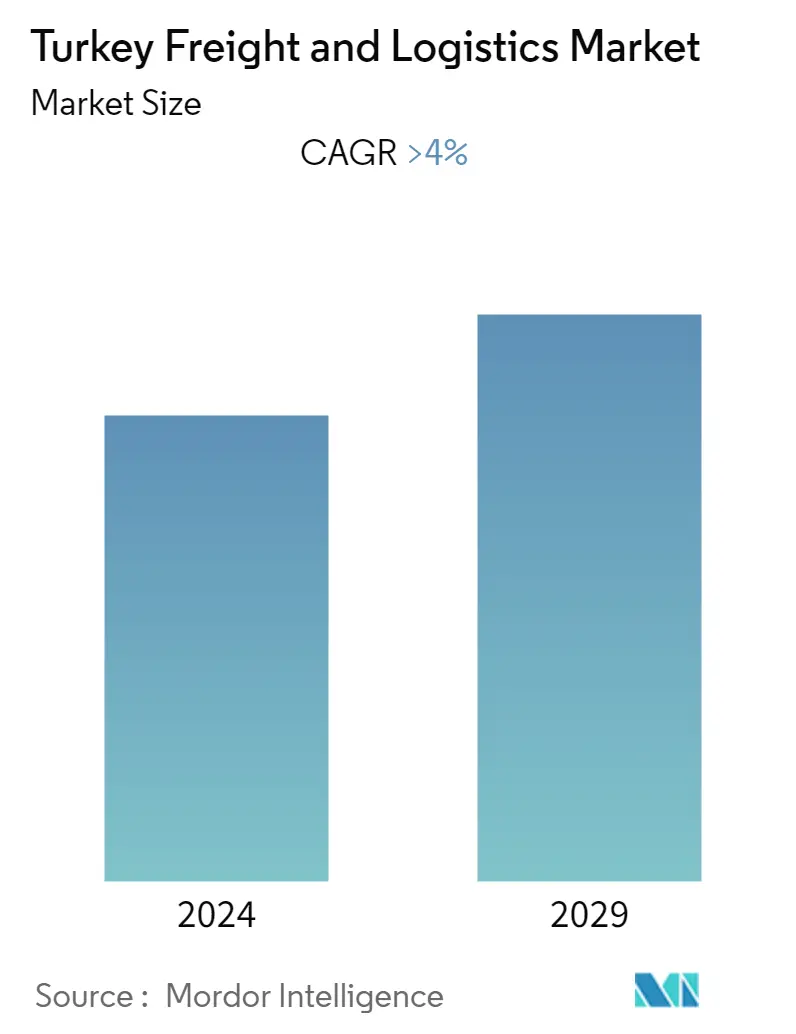Market Size of Turkey Freight and Logistics Industry

| Study Period | 2020 - 2029 |
| Base Year For Estimation | 2023 |
| Forecast Data Period | 2024 - 2029 |
| Historical Data Period | 2020 - 2022 |
| CAGR | > 4.00 % |
| Market Concentration | Low |
Major Players
*Disclaimer: Major Players sorted in no particular order |
Turkey Freight and Logistics Market Analysis
Turkey freight and logistics market is valued around USD 64 billion in the current year and is anticipated to register a CAGR of more than 4% during the forecast period.
- Due to its unique geostrategic position between Asia and Europe, manufacturing capacity, and logistical infrastructure, Turkey is at the core of economic activity in the region. Many demand drivers, such as economic development, a broad and export-oriented industry base, a robust retail market, and a quickly rising e-commerce sector, contribute to Turkey's logistics potential. By 2053, Turkey expected to invest heavily in expanding its railway and highway networks and building new airports. Between 2003 and 2021, approximately USD 172 billion in investments were made in five sectors, creating 17.9 million jobs. The investments will total USD 198 billion by 2053.
- It is expected that the industrial and logistics sectors, which are currently in recovery, will enter an expansion period with increasing demand and decreasing vacancy rates. With the opening of the Osmangazi Bridge and the establishment of new Organized Industrial Zones (OIZs), it is expected that the Yalova region and the Corlu-Cerkezkoy Buyukkaristiran region, along with the new Kapikule highspeed train project, will become critical industrial locations in the future.
- The last ten years saw almost USD 1.9 billion in foreign investments in the Turkish logistics industry. The growth of Turkey's logistics infrastructure is necessary, given the increasing trade flows between the emerging economies of Asia and Europe. Furthermore, the country has attracted foreign investment in logistics due to its anticipated benefits from China's One Belt One Road initiative.
Turkey Freight and Logistics Industry Segmentation
Logistics is managing the flow of things between the origin point and the point of consumption to meet the requirements of customers or businesses. It combines logistics experience, human resources, and knowledge to ensure the smooth journey of goods between carriers and shippers.
The market is segmented by Function (Freight Transport, Freight Forwarding, Warehousing, Courier, Express, and Parcel, Value-added Services, Cold Chain Logistics, Last Mile Logistics, Return Logistics, and Other Emerging Areas) and by End-User (Construction, Oil & Gas, and Quarrying, Agriculture, Fishing, and Forestry, Manufacturing & Automotive, Distributive Trade, Others (Pharmaceutical and Healthcare)). Reports also cover the impact of Covid-19 on the market. The report offers market size and forecasts for the Turkey Freight and Logistics Market in value (USD Billion) for all the above segments.
| By Function | ||||||
| ||||||
| Freight Forwarding | ||||||
| Warehousing | ||||||
| Value-added Services and Others |
| By End User | |
| Manufacturing and Automotive | |
| Oil and Gas, Mining, and Quarrying | |
| Agriculture, Fishing, and Forestry | |
| Construction | |
| Distributive Trade (Wholesale and Retail Segments - FMCG included) | |
| Other End Users (Telecommunications, Pharmaceuticals, etc.) |
Turkey Freight and Logistics Market Size Summary
The freight and logistics market in Turkey is poised for significant growth, driven by its strategic location between Asia and Europe, robust manufacturing capabilities, and expanding logistical infrastructure. The country's logistics sector is bolstered by a diverse and export-oriented industrial base, a strong retail market, and a rapidly growing e-commerce industry. Turkey's commitment to enhancing its transportation networks, including railways, highways, and airports, is expected to further strengthen its position as a key economic hub. The development of new industrial zones and infrastructure projects, such as the Osmangazi Bridge and the Kapikule high-speed train, are set to transform regions like Yalova and Corlu-Cerkezkoy into critical industrial centers. The influx of foreign investments, particularly in response to initiatives like China's One Belt One Road, underscores Turkey's potential as a logistics powerhouse.
The logistics industry in Turkey is heavily influenced by its manufacturing and automotive sectors, which play a crucial role in the country's economic landscape. With a significant portion of freight transported via roadways, Turkey's extensive road network is vital to its logistics growth. The country is also focusing on developing rail and coastal freight corridors to enhance its logistics capabilities. Despite challenges such as currency depreciation and the pandemic's impact, Turkey's e-commerce sector is experiencing rapid expansion, with Turkish companies gaining international recognition. The competitive landscape of Turkey's freight forwarding industry is marked by the presence of both domestic and international players, with major companies like CEVA Logistics, XPO Logistics, and DHL actively expanding their operations. These developments, coupled with strategic investments in infrastructure, position Turkey as a leading player in the global logistics market.
Turkey Freight and Logistics Market Size - Table of Contents
-
1. MARKET INSIGHTS AND DYNAMICS
-
1.1 Market Overview
-
1.2 Market Drivers
-
1.3 Market Restraints
-
1.4 Technological Trends and Automation
-
1.5 Porter's Five Force Analysis
-
1.5.1 Threat of New Entrants
-
1.5.2 Bargaining Power of Buyers/Consumers
-
1.5.3 Bargaining Power of Suppliers
-
1.5.4 Threat of Substitute Products
-
1.5.5 Intensity of Competitive Rivalry
-
-
1.6 Impact of Covid-19 on the Market
-
-
2. MARKET SEGMENTATION
-
2.1 By Function
-
2.1.1 Freight Transport
-
2.1.1.1 Road
-
2.1.1.2 Inland Water
-
2.1.1.3 Air
-
2.1.1.4 Rail
-
-
2.1.2 Freight Forwarding
-
2.1.3 Warehousing
-
2.1.4 Value-added Services and Others
-
-
2.2 By End User
-
2.2.1 Manufacturing and Automotive
-
2.2.2 Oil and Gas, Mining, and Quarrying
-
2.2.3 Agriculture, Fishing, and Forestry
-
2.2.4 Construction
-
2.2.5 Distributive Trade (Wholesale and Retail Segments - FMCG included)
-
2.2.6 Other End Users (Telecommunications, Pharmaceuticals, etc.)
-
-
Turkey Freight and Logistics Market Size FAQs
What is the current Turkey Freight and Logistics Market size?
The Turkey Freight and Logistics Market is projected to register a CAGR of greater than 4% during the forecast period (2024-2029)
Who are the key players in Turkey Freight and Logistics Market?
CEVA Logistics, DB Schenker, Ekol Logistics, DHL Supply and XPO Logistics are the major companies operating in the Turkey Freight and Logistics Market.

